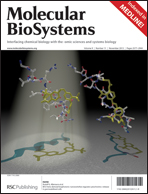An IgE receptor mimetic peptide (PepE) protects mice from IgE mediated anaphylaxis†
Abstract
Crosslinking of receptor-bound Immunoglobulin E (IgE) triggers immediate hypersensitivity reactions including anaphylaxis. Blocking the interaction of IgE with its high-affinity receptor, FcεRI, on mast cells and basophils is an attractive strategy for the treatment of allergies. This approach has seen clinical success using the anti-IgE monoclonal antibody, omalizumab. We recently designed and characterized a novel FcεRI–mimetic peptide (PepE) which contains the two key FcεRI α-chain receptor loops known to interact with the ε-heavy chain of IgE, C′–E and B–C, with an optimized linker for joining them. PepE has high specificity and affinity for IgE, blocks IgE binding to FcεRI and prevents IgE-induced mediator release from RBL2H3 cells. We have now investigated the biological effects of this peptide in vivo using a line of mice (BALB/c Il4raF709) very sensitive to IgE-mediated systemic anaphylaxis. IgE-deficient (IgE−/−) Il4raF709 mice were passively sensitized with the anti-DNP IgE monoclonal antibody (SPE-7) and subsequently challenged i.v. with DNP-BSA. Mice receiving a single dose of PepE prior to sensitization with SPE-7 IgE were fully protected from anaphylaxis while vehicle control-treated mice displayed strong reactions with significant core body temperature drops and elevated levels of mouse mast cell protease-1 (mMCP-1) in the serum. However, PepE had no effect on IgE-mediated anaphylaxis if given after IgE administration in IgE−/− mice, suggesting that PepE can block binding of free IgE to FcεRI but cannot compete with the receptor for already bound IgE in vivo. A single dose of PepE treatment did not protect IgE sufficient mice from IgE mediated anaphylaxis. However, a 3 week long course of PepE treatment protected IgE sufficient Il4raF709 mice from body temperature drops and elevation of serum mMCP-1. Our findings establish the potential of this type of structure for blocking IgE binding to mast cells in vivo and suggest that related peptides might have the potential to attenuate clinical allergic reactions.


 Please wait while we load your content...
Please wait while we load your content...